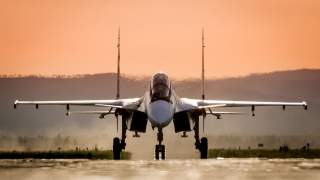Buyer’s Remorse: Does Belarus Wish It Bought F-16s Instead of Russian Su-30s?
Is that even possible?
Call it buyer’s remorse. But some critics in Belarus say the nation would have been better off buying U.S. F-16s instead of Russian Su-30 fighters.
In November 2019, Belarus received the first of its Su-30SM jets to replace its old MiG-29 jets. The Belarus air force will receive twelve Su-30SMs, at a cost of $600 million, or $50 million per jet. Comparing aircraft prices can be tricky, depending on whether the package includes also includes missiles and maintenance. But as a comparison, Taiwan wants to buy sixty-six F-16C/D fighters from the U.S. for $8 billion, or about $121 million per aircraft.
But a Belarussian news site suggests that the Russian jet will prove far more expensive in the long run.
“American experience shows that the cost of maintaining the fitness for operation of a combat aircraft for an estimated life of 35 years is 2 to 2.5 times higher than the purchase price of a machine,” writes sn-plus.com. “Thus, the price of capital, medium, current and minor repairs of each Belarusian Su-35SM in the next three decades will result in taxpayers of $100 million to $125 million.”
“But this figure is not final,” the publication adds. “The fact is that Soviet / Russian aircraft engines are traditionally inferior to Western ones not only in fuel efficiency, but also in turnaround and designated resources. The Polish Air Force simultaneously operates the Soviet twin-engine fighter MiG-29 and the American single-engine F-16. It is assumed that the American fighter flies all 35 years with the same engine that was originally installed on it. Unfortunately, this does not work with the MiG-29: eight engines will have to be replaced in the same period.”
The reliability of Russian jet engines has tended to be the Achilles heel of otherwise impressive aircraft designs. The article does acknowledge that while the MiG-29’s RD-33 engines are known to have problems, it is too early to assess the reliability of the AL-31FP engines on the Su-30SM, which first flew in 2012. The Su-30SM is an upgrade of the Su-30MK, with the latter being flown by China, India, Vietnam, Venezuela, Indonesia, Malaysia and Uganda.
“But unofficial data gives reason to believe that the Su-30SM ‘eats’ 6 engines during its life cycle (2 of which are already installed and paid for when purchased),” according to the article. “The new engine for the MiG-29 RD-33 costs around $ 2.5 million. AL-31FP will definitely be more expensive, because structurally more complicated due to the presence of a controlled thrust vector. So $10 million for engines is a deliberately understated amount.”
All of which will raise the final price of the Su-30 to $185 million to $210 million apiece over the next thirty-five years, the article estimates.
To be fair, many weapons—especially jet fighters like the American F-35 or Russia’s Su-57—tend to be more expensive than anticipated. Manufacturers and air forces have an incentive to underestimate costs to soothe taxpayers and budget officials. The F-16 and Su-30 are also different beasts (see a comparison here). The twin-engine, 17-ton Su-30 is a behemoth compared to the F-16, a single-engine jet that weighs in at about 10 tons.
In general, Russian weapons have a reputation for being cheaper than Western models. But Belarus’s experience suggests that the buyer may need to beware.
Michael Peck is a contributing writer for the National Interest. He can be found on Twitter and Facebook.
Image: Reddit.

